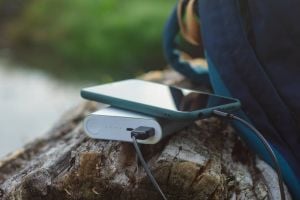When selecting a power bank, it is essential to understand several important factors to ensure you make the right choice. Learning how to choose a power bank involves carefully considering aspects such as capacity, portability, charging speed, and compatibility with your devices. By checking these features thoughtfully, you can select a power bank that meets your requirements and provides a reliable source of power when you need it most.

Editor
Mae An NG chevron_right
Table of Contents
What is a Power Bank?
A power bank is like your phone's emergency food stash; it's there when your battery runs low, and you're nowhere near a plug point.
It’s a portable battery that stores power, so you can charge your devices on the move. But not all power banks are built the same. Some charge fast, some take forever. Some can handle laptops, others can barely revive their phone.

How to Choose a Power Bank - Important Features to Consider
Learning how to choose a power bank is all about knowing your phone habits. Do you need one for long trips, or just a quick top-up after work?
Think about the capacity, the charging speed, and the safety features — then pick one that feels right for you. Here is what you need to know.
1. Battery Capacity (mAh)
This tells you how much charge it can store.
The higher the number, the more charges you get. But also, the heavier it’ll be.
|
Capacity |
What It Can Do |
Best For |
|
5,000 mAh |
1 full phone charge |
Light use, emergencies |
|
10,000 mAh |
2–3 phone charges |
Daily use |
|
20,000 mAh |
4+ phone charges, can charge tablets |
Travellers, power users |
|
30,000+ mAh |
Can charge laptops |
Content creators, digital nomads |
Tip: A 10,000 mAh power bank is the sweet spot for most of us, not too bulky, perfect for a full day out.
2. Charging Speed (Wattage + Fast Charging Support)
We’re in 2025. Waiting 5 hours for your phone to charge is a no-no. Look for these:
- PD (Power Delivery): Fast charging for iPhones, iPads, laptops
- QC (Quick Charge): Mostly for Android devices
- 25W or above: Great for modern devices like Galaxy S24 or iPhone 15
Local Trend Alert: With newer devices now supporting Qi2 wireless charging at 25W, more Malaysians are choosing power banks that support fast wireless output. No more cables? Indeed!
- Port Selection: USB-C is King
Check what kind of ports it has:
- USB-A: Old school, but still common
- USB-C: Modern and faster – best if it’s both input/output
- Lightning: Only useful if you’re stuck in the Apple ecosystem
Quick Tip: Go for a USB-C + USB-A combo. You’ll be ready for both new and old devices.
4. Size, Weight, and Design
Let’s be real – you’re not gonna carry a brick in your pocket daily.
- Slim and light: Good for handbags or pockets
- Chunky ones: Usually higher capacity, best for travel
- Built-in cables: Extra convenient, no need to bring extra wires
Malaysian Insight: Many users now prefer power banks that fit easily in crossbody bags, especially with the rise of minimalist EDC (Everyday Carry) setups among uni students and young adults.
5. Number of Devices It Can Charge at Once
Got a phone, wireless earbuds, and a smartwatch?
- Choose a power bank that can charge at least 2 devices at once
- Bonus if it supports wireless charging on top + wired charging below at the same time.
6. Build Quality and Safety Features
Don’t gamble with cheap, no-brand power banks from Shopee that overheat like sambal on max level.
Look for:
- Overcharge/short-circuit protection
- Temperature control
- Trusted brands (Anker, Aukey, Baseus, Ugreen, Xiaomi)
Extra Tip: In Malaysia, SIRIM-certified products offer better peace of mind.
7. Price and Value for Money
In 2025, you can find decent power banks starting from RM40. But don’t just go cheap — compare features!
|
Price Range |
What You Get |
|
RM30–RM60 |
5,000–10,000 mAh, slower charging |
|
RM70–RM150 |
10,000–20,000 mAh, fast charge, USB-C |
|
RM150+ |
20,000+ mAh, multiple ports, wireless charging, laptop support |
Tip: Look out for 11.11 and 12.12 Shopee/Lazada deals – perfect time to grab one with free shipping or cashback.
What’s Trending in Malaysia Right Now?
As of mid-2025, here’s what we’re noticing in the Malaysian tech space:
- Qi2 Wireless Charging is picking up fast. Expect more power banks with 25W wireless support hitting the market soon.
- Power banks with built-in stands or MagSafe rings are popular for TikTokers and mobile gamers.
- Eco-friendly or solar-powered models are also getting attention, especially from local hikers and outdoor lovers.
Pro tip: If you’re going to places with limited power, consider a solar charging power bank!
Best Power Bank for You
Here's how to choose a power bank based on your lifestyle:
For Students
Go for: 10,000 mAh, slim design, 2 ports
Why: Long university days + charging earphones & phones
For Grab Riders and Drivers
Go for: 20,000 mAh, fast charging (PD/QC), multi-device support
Why: Charging phones + dash cams
For Frequent Travellers
Go for: 30,000 mAh (TSA-approved), multiple outputs, laptop charging
Why: For flights, long-haul trips, or no plug access
For Content Creators
Go for: Fast charging, USB-C + wireless, power pass-through charging
Why: Charge cameras, phones, and shoot on the go
Final Thoughts

Choosing a power bank doesn’t have to be confusing. Once you know how to choose a power bank based on your daily habits, devices, and budget, it becomes super easy.
Just remember:
- Don’t chase the cheapest one.
- Pick what suits YOUR lifestyle.
- Look out for fast charging and safety features.
Today, it’s all about staying connected wherever you go. Whether you're at a durian stall in Penang or working remotely from a café in Bangsar, the right power bank keeps your device – and your life – powered up.
Ready to find your perfect match? Check out our list of the 10 Best Power Banks in Malaysia at ProductNation!
